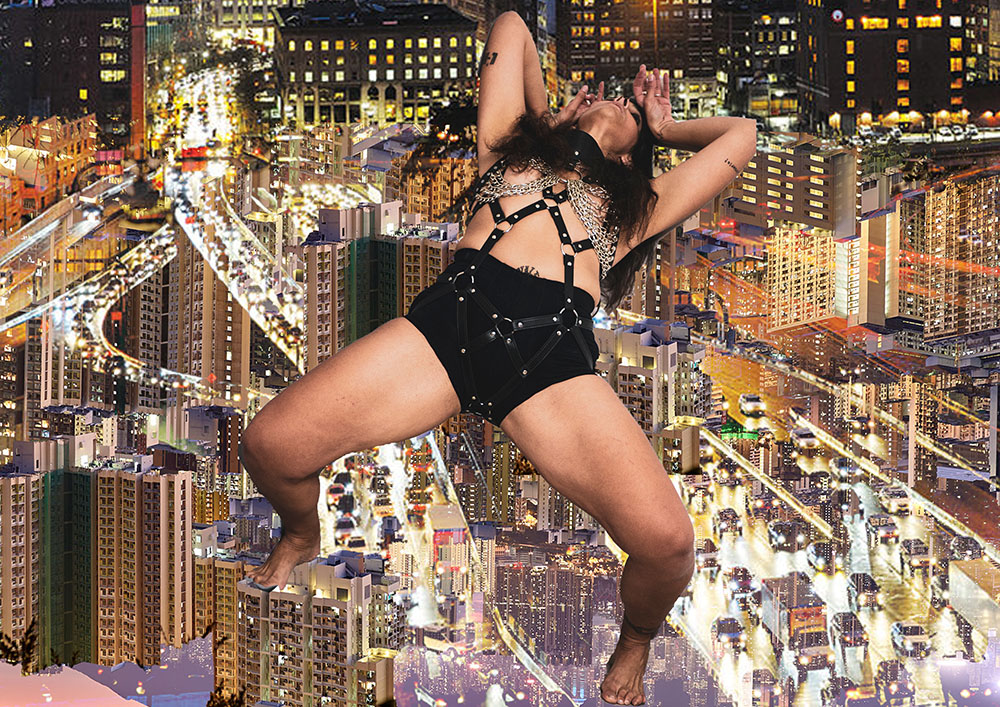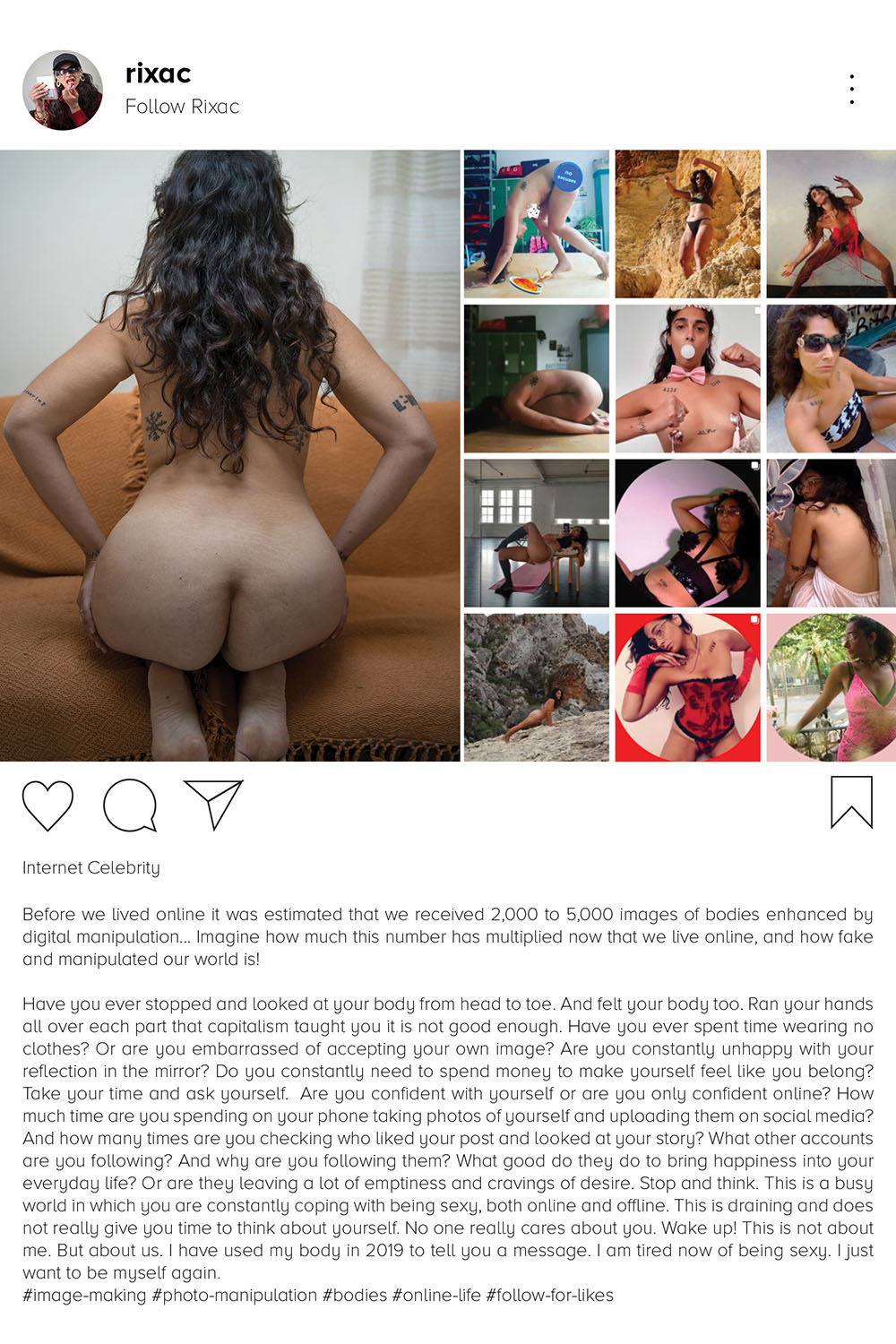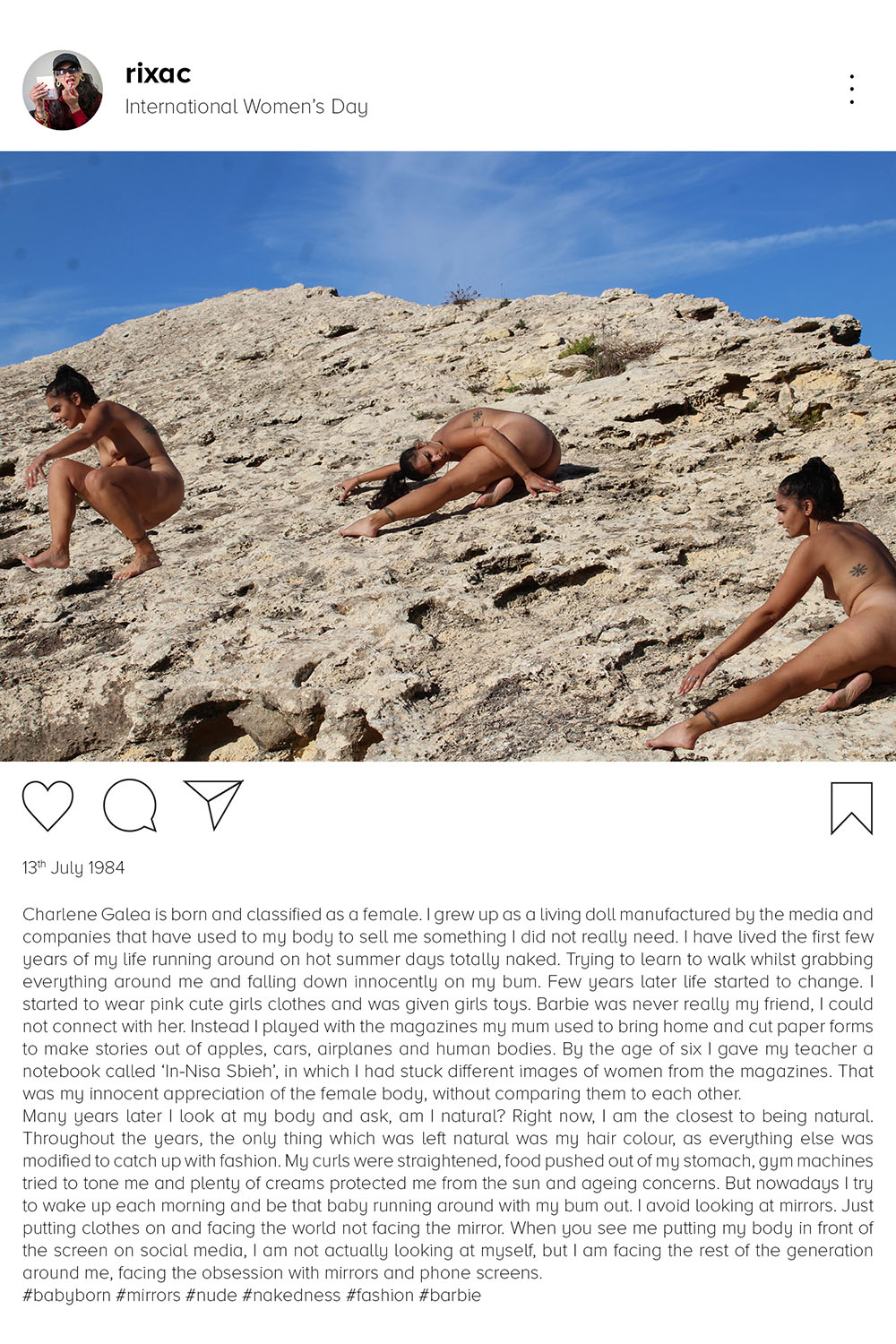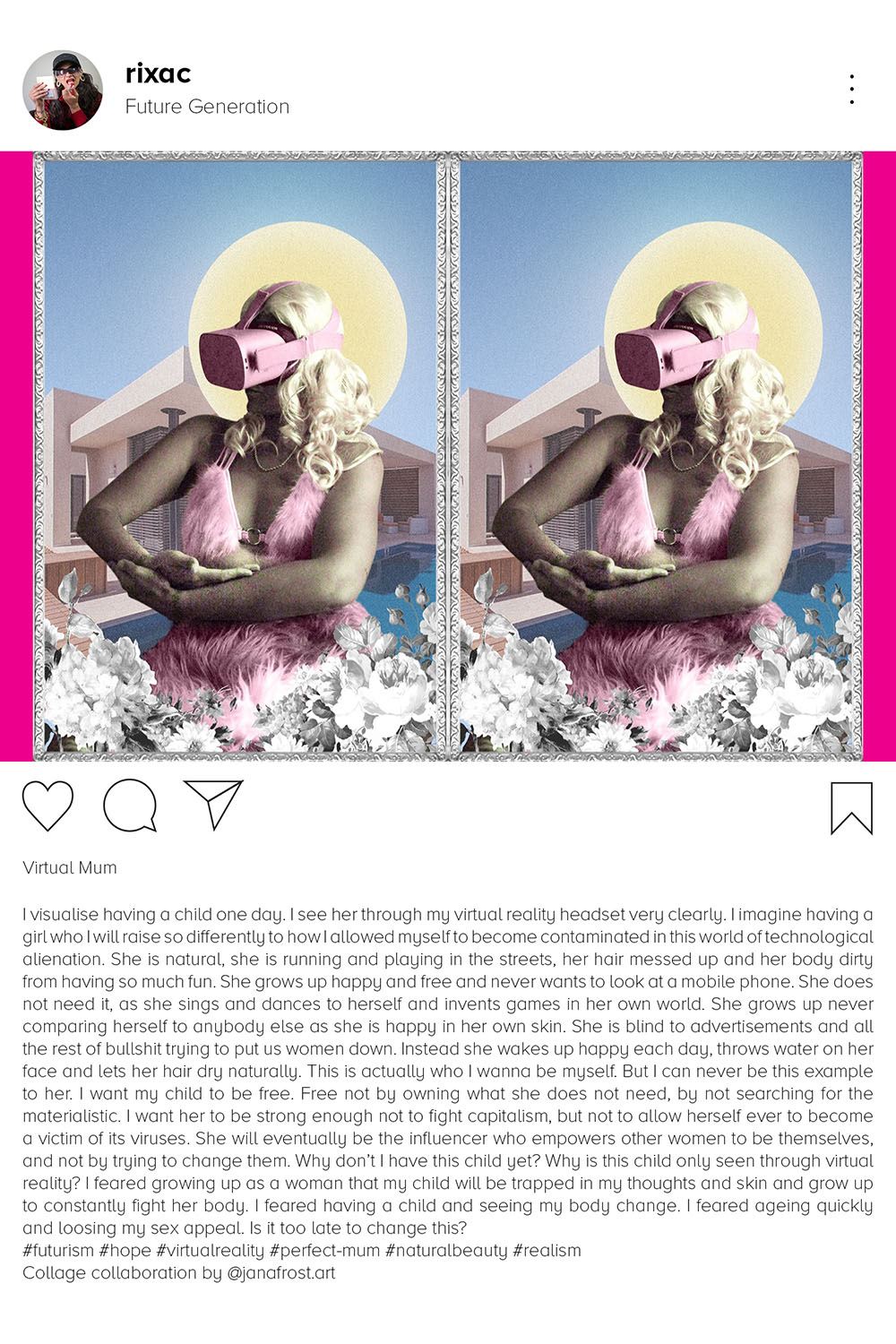
WHO IS Charlene Gálea?
Eve Cocks: From collaged photographs to relentless acts of self-production, you weave narratives of private experiences, your own and that of others.
Charlene Gálea: Autobiography is often embedded within my work, sometimes visible and obvious whilst at other times, it serves as a metaphor. I have no secrets about my private life, no fear to say how I robbed capitalism when capitalism was draining me in the city, no regret to say I slept very little to understand escapism and hedonism through clubbing, no shame to speak so openly about sex and random encounters or use my body as an object to address how we live. Ask me any question, and I will just tell you the truth because my private experiences formed my understanding of life and society around me.
EC: The ‘natural quality/rawness’ of your photography invites the viewer to meditate on the world of appearances, addictions and lies that have become part of our modern-day society.
CG: Even though I use Instagram a lot as my everyday office of sorts – as my medium to communicate messages to the public – I am constantly in touch with the reality of the outside world and connected with other human beings. It is very contradictory, but technology does not distance me from the truth of how we live. The rawness comes from the fact that I am so direct and spontaneous in the way I see life, perhaps also stemming from dark experiences in my past.
EC: Can you tell us about your early enthusiasm for self-performative images.
CG: Performance, to me, is like play; it reminds me of when I was a child on my own, inventing stories and games to pass the time, dressing myself up, role-playing and inventing a new world. Performance, to me, is about how the body can communicate all of these alternative realities through the imagination.

EC: People you have met in the past, either through your work or whilst clubbing or travelling, have helped you create all the character formations in your work.
CG: I have met all sorts of people from various backgrounds and social classes: refugees, criminals, lawyers, managers. In the clubbing experience, music unites all these people without pointing any fingers. I have helped them, and they have helped me, in forming social bonds when I was away from Malta and, I am still in contact with some of them. I am happy that some of these people have moved on towards an easier life. Living in the city sometimes means that people are carrying heavy baggage from their previous homes. This sort of understanding of the human condition has helped me be an artist. My best quality is not my technical skill but my personality. People trust me, open up to me and tell me their secrets. I am approachable and my body is a safe space you can rest your shoulder on whilst you tell me your problems. My best asset is my time rather than my paintbrushes.
EC: Not many are familiar with your early photo-documentary work which originates many years ago in the streets of Mexico, the Philippines and Barcelona.
CG: For a long time, I have kept the photography side of me half hidden, as I feel social media is so hyper-saturated with images (especially of superficial reality) that this sort of travel storytelling is not appreciated. You post a beautiful portrait or a landscape, and it’s lost in the feed. Then you post a silly selfie of yourself eating pasta carbonara looking hot and, suddenly, you are appreciated on Instagram. I treasure my photo-documentary work as it reminds me of the roads I risked to take when I was on my own, the strangers I stopped to talk to who trusted me to take their portrait, the time I took off paid work to explore and go on journeys to understand culture and how we live. I sometimes feel that if I post this online, the context and depth of these experiences are just consumed through an infinite feed. So I just post a pic of my ass. That gets a thumbs up!
EC: Text is an integral part of your work.
CG: Text Is feelings, and I have so many feelings. I am very conscious, sensitive and moody. Text helps me express all of that. Once I put my emotions into words, I am then free to feel more.

EC: You think of Instagram as more of a sketchbook.
CG: I write as soon as an idea strikes. Most of the time, I am annoyed at something I have seen or heard and I blurt it out. I write without stopping, then, after I post I usually go back and fix some word here and there, but I love spelling mistakes because they are authentic and friends who try to correct my English actually annoy me . That is my style of communication: blurting out the moment; it’s almost like vomiting emotions. I sometimes have the image and then a story comes to my mind or else I create an improvised shoot on the spot with whatever I find around me that can communicate the message.
Instagram is my free-rent space. When I came to Malta, no one knew about me or would have appreciated my ideas, especially art spaces or curators. So I used the digital platform without waiting for anyone in the art industry to give me space, DIY style. I always relied on my self to find my way and I know communication is the way to speak to an audience.
EC: Risk is also central to your work.
CG: As an extreme extrovert, risk is very important to me as it is the energy I feed my body to create and live. If I do not take risks, I am a very unhappy, energyless human body. As I’ve said to my skateboarder ex, skateboarders jump in the air and take that sort of risk. I get my adrenaline rush by taking my body to extreme situations. I love danger, anarchy, going against the media and contradiction. At my age, I am not trying to rebel. I take risks to find solutions to what is opposite of the norm, of what everyone else follows.
EC: You mentioned how posing nude for drawing classes has helped you confront “your own being”.
CG: I had low self-confidence and suffered from food disorders growing up. I started to overcome these through self-portraits and exploring my own body through photography, but life drawing means you are on stage being watched. Those who are drawing you believe that your body is beautiful, not just aesthetically, but as that energy that inspires them to transform your presence into an art piece.

EC: Online harassment is a sad reality for artists like you.
CG: The nude body is still accepted as OK in painting and sculpture but, in photography, it is censored or looked at and seen as vulgar and cheap. I received phone calls asking me for sex and dick pictures sent to my in box; my images were shared between groups of friends as a laugh.
EC: Your first solo show PRIVAT: THE NATURAL BODY AS FICTION had to close shortly after its launch due to the current COVID-19 situation. Can you tell us more about the exhibition and would you consider offering virtual tours online?
CG: The project was really relevant before COVID-19 as the research is about the commodification of the female body and identity as seen online. It’s about feeling the need to be seen as sexy and the efforts to be perceived as such, the competition between women and the repression women have to suffer to be seen as sexy. The exhibition criticises how capitalism has turned us into objects of display and focuses on erotic capital as promising women that that is what it takes to be happy when, in reality, all it does is make a woman feel that she is never enough. The exhibition closed three days later, and I have not really been keen to talk about this work. When I think about the fact that there are people out there struggling to survive, I feel that the subject has lost its immediacy as it lacks a connection to what is happening around us on a worldwide level. The exhibition also included a live performance which treated the layers of the woman as revealing and concealing truth or lies about her feelings as a woman. The outfit has been designed out of recycled pieces of material by Sarah Portelli.
EC: You would like to be more involved in freedom of movement in public spaces.
CG: The street is my biggest love. The problem is that our streets are not public; they are private. In our modern times, we have never learned how to use the street properly. We use them to go to work, to spend our money in restaurants and shops and to drive cars. So, as much as I love to have more of my work displayed in public spaces, people first need to start loving and appreciating the outside world more.
Charlene Gálea is a conceptual artist whose body often navigates between online identity and physical experience. The works featured in this article formed part of Charlene’s first solo show PRIVAT: THE NATURAL BODY AS FICTION. The exhibition was supported by The Gabriel Caruana Foundation and held in collaboration with Jana Frost, Etienne Farrell, Taras Stash, Lisa Attard, Florinda Camilleri and Sarah Portelli. All images courtesy of the artist.
You can follow Charlene on Instagram
